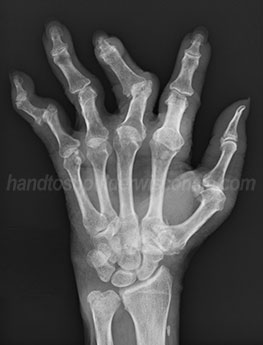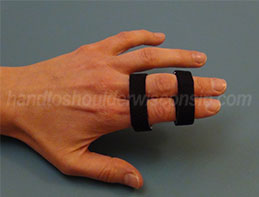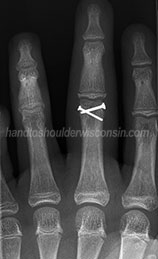At Hand to Shoulder Center of Wisconsin, our team of orthopedic specialists are here to diagnose and treat your finger fracture. When you’re seeking a team of orthopedic doctors and occupational and physical therapists with extensive experience with finger fracture treatment and care, contact Hand to Shoulder Center of Wisconsin in Appleton or Green Bay.
What is a Finger Fracture?
Fingers are made up of 14 small bones called phalanges (singular form: phalanx). When a finger is broken or cracked, one or more of the phalanges are affected. This is referred to as a finger fracture or broken finger.
Although fingers are a small part of the anatomy, a fractured finger is not a minor injury. In a non-injured finger, the bones are aligned precisely for ease of movement such as gripping, grasping, and manipulating small objects. When one or more of the bones are damaged, it can affect the function of the entire hand, causing pain, stiffness, and loss of movement. Without treatment, a finger fracture can cause problems including prolonged stiffness and pain.
Finger Fracture Symptoms and Causes
Depending on the severity of the injury, broken finger symptoms can range from mild to extreme pain, swelling, and bruising. Sometimes, numbness and tingling may also affect the finger and/or hand. With some types of fractures or displacements, a visual deformity may occur (Fig. 1).

Figure 1: Finger fractures with visual deformity
Commonly known fractures include:
- A non-displaced fracture, is more commonly known as a hairline fracture. This consists of a thin crack in the bone that occurs with an injury. Typically, it is not as noticeable as other types of fractures, however, localized pain, tenderness, or soft tissue swelling are a few of the common symptoms.
- A displaced fracture occurs when the fracture causes a change in the alignment of the bone (Fig 2).
- An open fracture occurs when there is a break in the bone as well as a break in the skin, which sometimes exposes the bone.
- An avulsion fracture occurs when the tendon or ligament pulls away a small portion of bone from the main mass of bone.
- A comminuted fracture is when the bone breaks in three or more pieces.
- A pathologic fracture occurs in the bone when they are weak due to certain bone disorders, such as cancer or a bone cyst (holes in the bone). This type of fracture is less commonly seen.

Figure 2: Thumb fracture
Causes of finger fractures are many; however, most finger fractures happen from some form of injury to the hand such as a fall, sports injury, or another type of trauma such as a crush injury.
Diagnosis and Finger Fracture Treatment
The orthopedic physicians at Hand to Shoulder Center of Wisconsin are highly experienced in all hand and upper extremity injuries and conditions. A thorough examination is conducted and all prior hand injuries and conditions are explored. The evaluation will consist of a visual examination of the alignment of the fingers along with the flexibility of the hand and how the fingers line up when making a fist. X-rays will be taken and a diagnosis will confirm the location and the type of fracture.
Depending on the stability and location of the fracture, surgery may or may not be needed. Non-surgical treatment typically will consist of splint application to the injured finger or hand (Fig. 3). In some cases, the finger adjacent to the injured finger will be used as a splint; this technique is referred to as buddy taping (Fig. 4).
 Figure 3: Finger splint |
 Figure 4: Budding taping |
In some cases, the orthopedic physician will manipulate or “reduce” the fracture back into place and cast or otherwise immobilize it; keeping it from movement.

Figure 5: Screws are placed at the fracture site to hold bones together
In some finger fractures, surgery may be required. Surgery may include placement of pins, screws, and/or wires to realign and hold the broken bones together (Fig. 5).
Rehabilitation may be ordered by your surgeon to aid in the recovery. At Hand to Shoulder Center of Wisconsin, a physical or occupational therapist will work closely with you to increase your strength and ability to perform daily activities. Therapy often plays a huge role in the recovery.
Finger fracture healing time varies depending on the severity of the fracture.